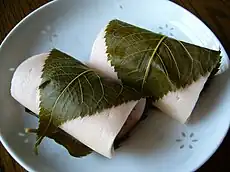Sakuramochi
Sakuramochi (桜餅) is a Japanese confection (wagashi) consisting of sweet, pink-colored rice cake (mochi) with a red bean paste (anko) center and wrapped in a pickled cherry blossom (sakura) leaf. Different regions of Japan have different styles of sakuramochi. Kanto-style uses shiratama-ko (白玉粉, rice flour) to make the rice cake, and Kansai-style uses dōmyōji-ko (道明寺粉, glutinous rice flour). The sweet is traditionally eaten during the spring season, especially on Girl's Day (hinamatsuri; March 3) and at flower viewing parties (hanami).[1]

The interior of a sakuramochi, showing the red-bean paste inside.
 Sakuramochi (Kanto-style) | |
| Place of origin | Japan |
|---|---|
| Main ingredients | Sweet pink-colored rice cake, red bean paste, pickled cherry blossom leaf |
| Other information | Traditionally consumed on Hinamatsuri and at Hanami |

Kansai-style sakuramochi

Sakuramochi (a variation of Kansai style)
The leaf may or may not be eaten depending on individual preference.
Types of sakuramochi
Sakuramochi differs by shapes and recipes, depending on areas it was made.
- Kanto-style sakuramochi
- Sakuramochi made in Kanto area. Outside of Kanto-area the Kanto-style sakuramochi is also known as chōmeiji-mochi (長命寺餅), named after a temple near the shop first sold the sweets).
- Kanto-style sakuramochi is often sold together with Kansai-style sakuramochi in supermarkets.
- Kansai-style sakuramochi
- Sakuramochi made in Kansai area. Also known as dōmyōji-mochi (道明寺餅) or simply dōmyō-ji (道明寺, another temple who invented the flour used).
- Kanto-style sakuramochi is available only in the Kanto-area. "Sakuramochi" is a common term to refer to the widely available Kansai-style mochi.
See also
- Sakurayu
- Sakura cheese
- Hwajeon
- Japanese tea ceremony
- Wajik
- Kashiwa mochi
- Hanabiramochi
- Hishi mochi
- Warabimochi
- Zunda-mochi
- Kuzumochi
- Kusa mochi
- Hyōroku mochi
- Botamochi
Wikimedia Commons has media related to Sakura mochi.
References
- "Only In Spring! Seasonal Japanese Desserts You Should Try". favy. Archived from the original on 4 April 2017.
This article is issued from Wikipedia. The text is licensed under Creative Commons - Attribution - Sharealike. Additional terms may apply for the media files.